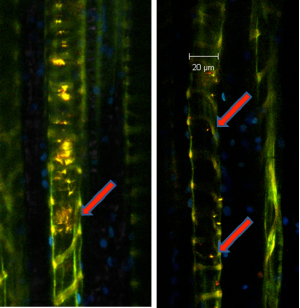Nanotechnology and strategies for sustainable protection from the Olive Quick Decline Syndrome
Giuseppe Ciccarella (1,2), Francesca Baldassarre (3)
(1) Department of Engineering for Innovation, University of Salento, Monteroni Street, Lecce I-73100, Italy
(2) Institute of Nanotechnology, CNR NANOTEC, Lecce I-73100, Italy
(3) Department of Cultural Heritage, University of Salento, Lecce I-73100, Italy
Introduction
The Olive Quick Decline Syndrome, denoted CoDiRO, is the Olive Trees disease observed in Salento (Apulia, southern Italy) that is associated to Xylella Fastidiosa (X.f) infection [1,2].
The impact of infection by X.f is devastating for the local economy, especially considering the high value of the ancient monumental olive trees (trees older than 100 years). Although the traditional approach versus bacterial diseases is the infected plants eradication but the economic value of each tree requires the research of alternative strategies.
Methods
Our aim is the development of innovative remedies based on nano-carriers, ie very small particles, which are smaller than bacteria and comparable with viruses.
The technology of nano-carrier is the last frontier of drug discovery as it allows to amplify the drug effect both in effectiveness that in selectivity. All this translates in the administration of low drug doses to the infected plant.
Results
The nanocarriers are made with non-toxic, biocompatible and extremely cheap material in order to obtain an economically and environmentally sustainable solution.
Preliminary studies conducted in our laboratory have demonstrated the mobility of the nanocarriers in xylem vessels, without any effect on the plant tissues nor uptake by the vegetable cells. The nanoparticles mobility was observed in sections of xylematic vessels by confocal microscope as reported in figure1.
The nanocarriers are therefore free to travel and selectively hit the bacteria as missiles, hopefully, releasing specific anti-Xylella substances.
This innovative protection strategy is supported by a work of "intelligence", namely the development of early diagnosis methods for X.f infection.
Conclusion
Today we can find the presence of Xylella cells in infected material deriving from a single leaf using specific molecules emitted by bacteria metabolism. In the coming months we will test this methodology on a large population of olive trees with the intent to verify its effectiveness on the ground as highly specific diagnosis method allowing wide-spread, rapid and inexpensive monitoring for X.f pathogen.

Figure 1. Microscopic images of xylematic vessels in which we can observe the presence of nanocarriers as indicated by red arrows. The nanocarriers were suitably labeled with fluorophore for the observation.
References
[1] Cariddi C., M. Saponari, D. Boscia, A. De Stradis, G. Loconsole, F. Nigro, F. Porcelli, O. Potere and G.P. Martelli, 2014. Isolation of a Xylella fastidiosa strain infecting olive and oleander in Apulia, Italy. Journal of Plant Pathology 96(3), 1–5.
[2] Saponari M, D. Boscia, F. Nigro and G.P. Martelli, 2013. Identification of DNA sequences related to Xylella fastidiosa in oleander, almond and olive trees exhibiting leaf scorch symptoms in Apulia (Southern Italy). Journal of Plant Pathology 95, 668.
Biosketch
Giuseppe Ciccarella is Permanent Senior Staff Researcher, teaching Fundamentals of Chemical Technology, at the Faculty of Engineering University of Salento (Department of Engineering for Innovation). Since 2007 he is research associate to CNR-NANO Institute for Nanoscience – Responsible for Nanomolecular Technologies Laboratory. Research activity is mainly focused on experimental activity concerning synthesis and analysis of new organic and inorganic materials for sensing, renewable energy and nanomedicine. This activity is well documented by over 60 scientific publication on peer-reviewed journals (ISI), 5 patents and various communications to international conferences.
Contacts
Dr. Giuseppe Ciccarella, Ph.D.
Phone +39 083229 8233
Fax: +390832298278
Questo indirizzo email è protetto dagli spambots. È necessario abilitare JavaScript per vederlo.



